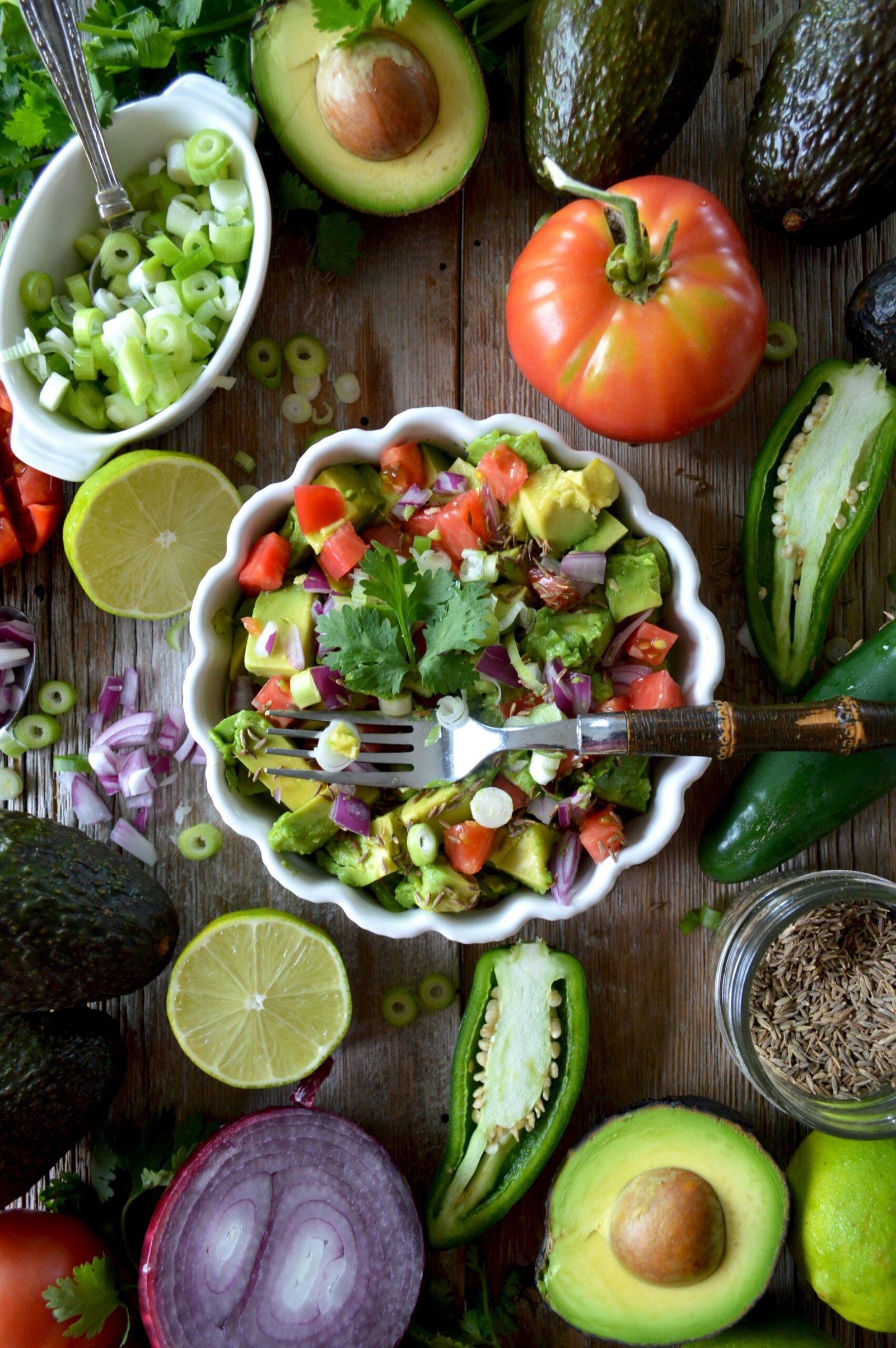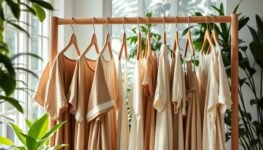
Eco-Conscious Style: Exploring Sustainable Fashion Brands
The fashion world is growing fast, but so is its environmental impact. Fashion production is now up to 10 percent of global carbon emissions1. Sustainable fashion brands are stepping up, providing clothes that are good for the planet and fair for workers. More people want clothes made with care for the environment, using better materials and green production methods1. Can these brands really help lessen the fashion industry’s big environmental footprint?
Key Takeaways
- Sustainable fashion means making clothes, shoes, and accessories in ways that are kind to the planet1.
- It’s all about being open about where things come from, treating workers right, and making less waste1.
- More people want clothes that are good for the planet, using better materials and green ways to make them1.
- Sustainable fashion brands are using recycled stuff, following the circle of life, and saving energy1.
- It’s up to us to help by picking eco-friendly clothes and supporting brands that care1.
- The fashion world is finding new ways to source, make, and share clothes to be more green1.
What is Sustainable Fashion?
Sustainable fashion means making clothes, shoes, and accessories without harming the environment. It focuses on clear supply chains, fair labor, and using old materials in new ways2. Knowing about sustainable fashion helps people choose better clothes and support good brands.
Green fashion brands use methods that are kinder to the planet and reduce waste. This shows a big change towards caring for the environment in the fashion world2. The fashion industry is a big polluter, causing 8-10% of global greenhouse gas emissions2.
Key Principles of Sustainability
Important parts of sustainable fashion include using recycled materials and cutting down on waste. Brands like E.L.V. Denim and Ninety Percent are great examples. They make clothes from recycled materials and give a lot of their money to help people involved in making clothes3.
Choosing sustainable fashion helps make the fashion world better for our planet and people. As more people want green fashion, brands are starting to use eco-friendly ways to make clothes. This makes it simpler for us to pick clothes that are good for the planet3.
The Rise of Sustainable Fashion
The fashion world is changing fast, moving towards being more eco-friendly. This change is because more people want clothes made in ways that are good for the planet and fair to workers4. They look for designers and brands that use green materials and are open about how they make their clothes4.
For a long time, the fashion industry was seen as not very green. It was known for fast fashion, lots of waste, and treating workers poorly5. But now, more people are asking for clothes made in a better way. This has made companies change, adding eco-friendly steps to their making process4.
Now, people are choosing clothes that are good for the planet. They like buying second-hand, swapping clothes, and even renting them6. As more people want green fashion, it’s likely that the whole industry will keep moving in this direction4.
https://www.youtube.com/watch?v=i-dFTOthHdU
Brands like Patagonia, Reformation, and Everlane are at the forefront of this change. They’ve made big promises to be more sustainable and open about their practices4. These brands show that you can be stylish and also care about the planet.
Popular Sustainable Fashion Brands
Many brands are making a big impact in the world of eco-friendly clothes. Patagonia, Reformation, and Everlane are leaders in using green materials and fair production methods7. They also share important info with their customers about why sustainable fashion matters.
Some top names in sustainable fashion include:
- Stella McCartney, known for its commitment to responsible practices for over 20 years8
- Vivienne Westwood, a true pioneer in sustainable fashion
- Mara Hoffman, focusing on green materials and being open about their practices7
These brands are at the forefront of using eco-friendly materials and fair production. They are great choices for those who want to help the planet8.
By picking sustainable fashion brands, we can all help lessen the fashion industry’s harm to the environment7.
| Brand | Sustainability Initiative |
|---|---|
| Patagonia | Environmental grants and activism |
| Reformation | Climate positive goal by 2025 |
| Everlane | 100% certified recycled, organic, renewable, and responsibly sourced materials by 2025 |
Materials That Make a Difference
Sustainable fashion brands are now using materials that are better for the planet. This move towards environmentally conscious fashion brands is key to lessening the fashion industry’s harm. The industry is responsible for 2 to 8 percent of global carbon emissions9. Brands are choosing sustainable materials like organic cotton, Tencel, Lyocell, and recycled fabrics.
Sustainable fashion brands prefer organic cotton because it needs less water and pesticides than regular cotton. Tencel and Lyocell are also popular for their low environmental impact10. Plus, recycled fabrics help reduce waste and support a circular fashion system.
Organic Cotton
Organic cotton is a top choice for sustainable materials. It’s grown without harmful pesticides or synthetic fertilizers, which is better for the environment. The Classic T-Shirt Company uses 100% organic cotton for their products11.
Tencel and Lyocell
Tencel and Lyocell come from wood pulp and are biodegradable and compostable. They have a low environmental footprint10. Brands like Tove & Libra are adding these materials to their collections.
Recycled Fabrics
Recycled fabrics are key in sustainable fashion. They help cut down waste and save resources. By using recycled materials, brands can lessen their environmental impact and offer more sustainable fashion choices to consumers.
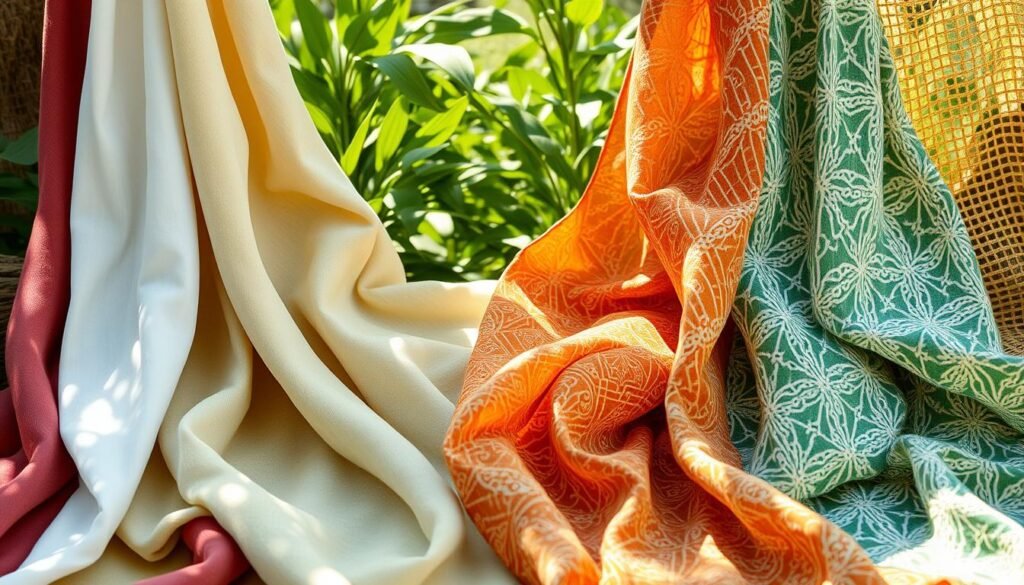
In summary, using sustainable materials is vital for a greener fashion industry. As consumers, we can help by choosing products from organic cotton, Tencel, Lyocell, and recycled fabrics. This supports environmentally conscious fashion brands and helps create a sustainable future for fashion9.
Ethical Production Practices
More people now care about the impact of what they buy. Ethical apparel brands are becoming more popular. They make sure workers get paid well and work in safe places12. Sustainable fashion designers also want to be open about where their materials come from. This helps people make better choices about their clothes.
Important parts of ethical making include fair trade and paying workers a fair wage12. Sustainable fashion designers also try to use less waste and be kinder to the planet. They might use recycled stuff, use less water, and make things in ways that are better for the environment.
Choosing ethical apparel brands and sustainable fashion designers helps fight for fairness and stops exploitation. Brands like L’Envers and Proclaim are good examples. L’Envers makes things only when they’re ordered to cut down on waste12. Proclaim offers many sizes and cares about treating workers right13.
When you’re looking for clothes that are good for the planet and people, look for brands that are open and fair. Check for fair trade and organic cotton labels12. By choosing wisely, you help make fashion better for everyone.
Sustainable Fashion for Everyday Wear
Sustainable fashion is not just for special events or luxury brands. Many eco-friendly clothing companies offer stylish options for daily wear. Whether it’s casual or business attire, you can choose sustainable pieces that match your style and values. Brands like Jenni Kayne and Reformation make stylish, eco-friendly clothing for everyday14.
Popular sustainable fashion brands have a variety of items like dresses, tops, and pants. They focus on sustainability and use green materials. You can build a sustainable wardrobe that’s both stylish and eco-friendly. Look for fair trade and organic cotton certifications to ensure products meet sustainability standards15.
Supporting sustainable fashion brands also means donating old clothes and buying second-hand. This reduces waste and supports the circular economy. Experts say donating clothes is a sustainable way to get rid of old items15. By doing this, you help the fashion industry become more sustainable and support eco-friendly clothing companies.
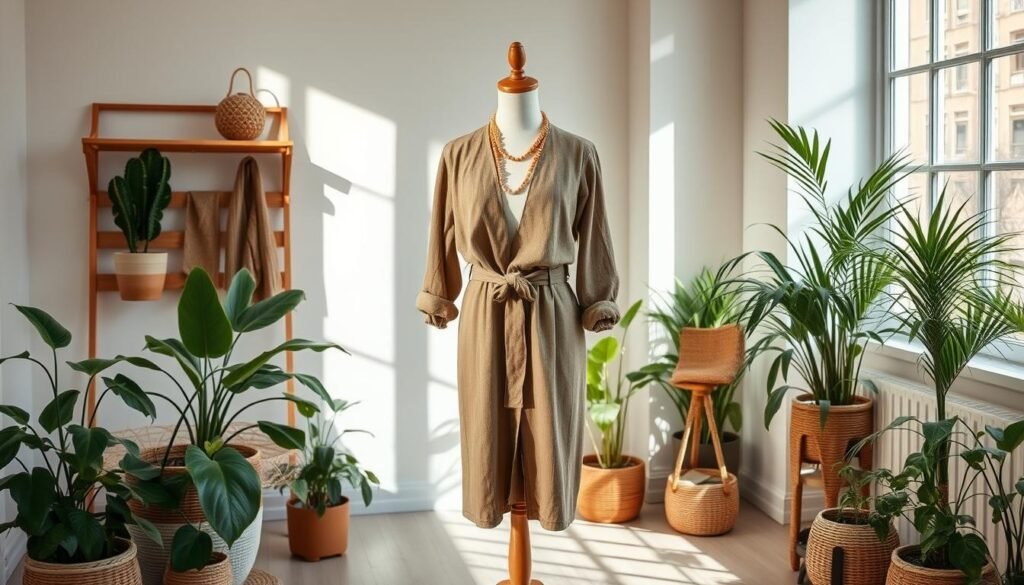
Sustainable fashion is getting easier and more affordable. With more eco-friendly clothing companies and sustainable fashion brands, you have many choices. By choosing sustainable options, you positively impact the environment and support a greener fashion industry14.
| Brand | Product | Price |
|---|---|---|
| Jenni Kayne | Casual dress | $250 |
| Reformation | Top | $100 |
| Pact | Organic cotton pants | $80 |
For more info on sustainable fashion, check out The Good Trade or Healthy Shopper Placer.
Innovations in Sustainable Fashion
The fashion world is always changing, and sustainable fashion is leading the way. New technologies and materials are being created to cut down waste and protect the environment16. For example, Refiberd is recycling old clothes into new threads, using up to 93% of the original garment16. Also, fabrics made from plants like organic cotton and hemp are becoming more popular because they’re better for the planet17.
Some big changes in sustainable fashion include:
- Modular fashion, which encourages us to think more about what we buy and how long it lasts17
- 3D printing, which lets us make clothes just for us, cutting down on waste from too much stuff17
- Virtual fitting rooms and 3D body scanning, making shopping greener by reducing the need for shipping and returns17
These new ideas could really change the fashion world for the better. As we move forward, we’ll see even more ways to make fashion more eco-friendly18.
| Innovation | Description |
|---|---|
| Refiberd | A recycling process that creates new threads from old garments |
| Modular fashion | A approach to fashion that promotes versatility and longevity of clothing items |
| 3D printing technology | A technology that enables on-demand production of custom-designed garments |
How to Identify Sustainable Brands
Finding sustainable fashion brands can be tough. But, there are clear signs to look for. Brands that care about the planet and people often have special labels. Look for the UN Guiding Principles on Business and Human Rights19 to start.
Check the materials and how they’re made. Eco-friendly brands focus on using less waste and promoting recycling. Patagonia and Levi’s are great examples, using organic cotton and avoiding harmful chemicals19. Fast fashion, on the other hand, is all about quick, cheap clothes.
Certifications and Labels to Look For
Look for Cradle to Cradle, OEKO-TEX, and GOTS labels. These show a brand’s dedication to being green. They check on things like how much resources are used and how animals are treated20. Also, brands that share their sustainability efforts openly are good choices.
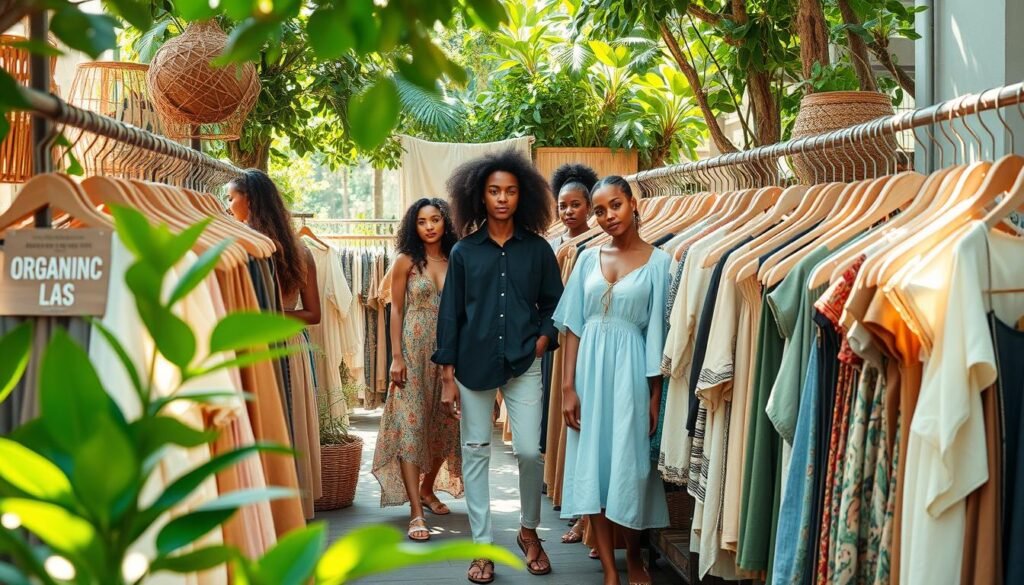
Red Flags in Fast Fashion
Be wary of very cheap clothes and brands that don’t talk about their making process. Fast fashion focuses on being cheap and quick, not on being kind to the planet. By choosing sustainable brands, we help make fashion better for everyone.
| Certification | Description |
|---|---|
| Cradle to Cradle | Assesses a brand’s commitment to sustainability and environmental responsibility |
| OEKO-TEX | Certifies brands that meet high standards for environmental and social responsibility |
| GOTS | Ensures brands meet strict criteria for organic and sustainable production practices |
The Role of Consumer Awareness
Consumer awareness is key in pushing for sustainable fashion. Studies show 66% of people want sustainable fashion21. Yet, only about 10% of the fashion market is green22.
Every person’s choices matter. Americans throw away 81 pounds of clothes yearly21. This adds up to 10% of global waste from the fashion industry21. By choosing eco-friendly brands, we can help.
The Impact of Individual Choices
Our choices can make a big difference. People are willing to spend more on green fashion21. Knowing the benefits and costs of sustainable fashion helps us make better choices.
Case Studies of Successful Campaigns
Campaigns like “Fashion Revolution” show the impact of awareness. They teach us about fashion’s environmental harm22. As we learn, we choose better and support green brands.
Retail Strategies for Sustainable Fashion
Eco-friendly clothing companies are using new ways to sell sustainable fashion. They encourage buying secondhand and vintage to cut down on waste. Stores like The RealReal and Farfetch are at the forefront, selling pre-owned and vintage clothes23.
These brands also offer clothing swaps and rent-the-runway services. This lets customers try new looks without buying new clothes. It’s a smart way to save money and be eco-friendly. A study shows 73% of millennials are ready to pay more for green fashion23.
These strategies bring many benefits:
- Less waste and longer-lasting clothes
- More engaged and loyal customers
- Chances for companies to push sustainable fashion
Eco-friendly clothing companies are helping the planet by choosing sustainable options. The market for sustainable fashion is expected to grow fast, showing these strategies are good for business and the environment24.
As people care more about the planet, they look for brands that do too. By using eco-friendly materials and reducing waste, retailers can attract more customers. This helps them stand out in the sustainable fashion world24.
Challenges Facing Sustainable Fashion Brands
Sustainable fashion brands face many challenges. One big issue is the high cost of materials like organic cotton. This makes it hard to make clothes that are both green and affordable25. The fashion world also creates a lot of carbon emissions, up to 10% of the world’s, as the UN says25. So, these brands must find new ways to be kinder to the planet.
Another big problem is getting noticed in a crowded market. Fast fashion is cheap but often made in bad conditions, hurting workers26. Also, very little old clothes get turned into new ones26. Sustainable brands need to create systems where clothes can be made over and over again. But, there’s no law to make fast fashion brands act better, making it tough for green brands26.
Some of the main hurdles for sustainable fashion brands include:
- High upfront costs of sustainable materials
- Difficulty in scaling up production while maintaining ethical practices
- Lack of government policies and industry regulations supporting sustainable fashion
- Intense competition from fast fashion brands
But, many sustainable fashion brands are coming up with creative solutions. They use eco-friendly materials, cut down on waste, and work towards making clothes in a loop25. This is helping to make the fashion world more sustainable for everyone25.
The Future of Sustainable Fashion
The future of sustainable fashion is bright, with many brands focusing on being green and open. As more people want clothes that are good for the planet, we’ll see new and better ways to make them. This will include brands that care deeply about the environment.
Brands that focus on sustainability are changing the game in fashion27. They’re making more money than others in the industry. Also, they’re making older people want to shop in a way that’s better for the planet28.
Big changes are coming, like using the same materials everywhere and making clothes that can be recycled27. We’ll also see new ways to pack clothes to cut down on waste and save money27. Plus, new tech like algae dyes and AI for recycling clothes will help fight pollution and make fashion more sustainable27.
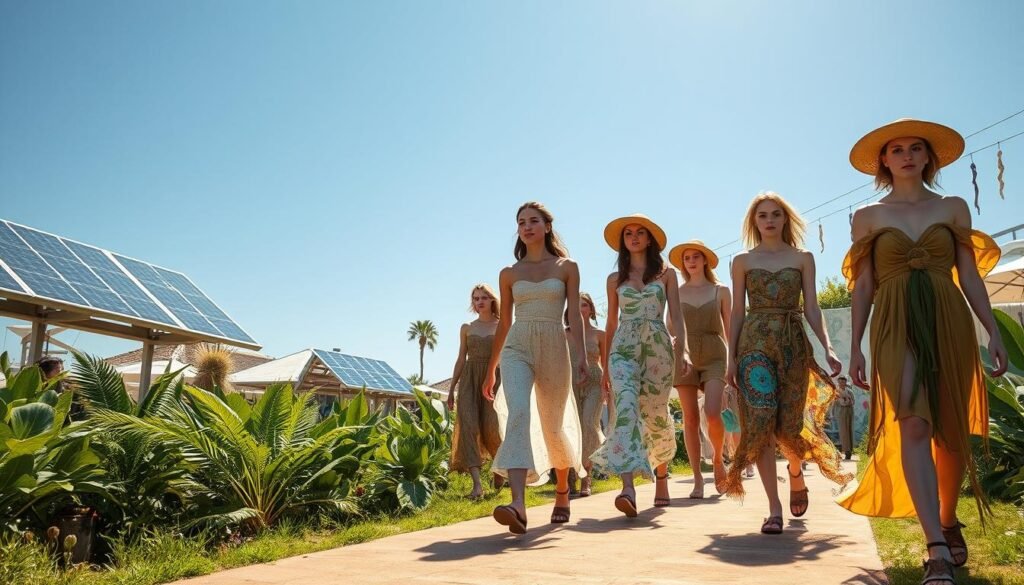
Predictions for the Industry
- Increased use of environmentally friendly fabrics
- More transparency in supply chains
- Greater emphasis on circularity and recycling
Keep an eye out for new brands that put sustainability first, like Patagonia and Reformation27. These leaders in sustainable fashion are showing others how it’s done. Their dedication to the planet is motivating many to follow their example28.
Addressing Greenwashing in the Fashion Industry
The fashion world is dealing with a big problem: greenwashing. Many brands make false claims about being eco-friendly29. This can hurt their sales as people lose faith and look for better choices29. It’s key to know what greenwashing is and how to spot it.
There are some good certifications out there like 1% for the Planet, Fairtrade, Oeko-Tex, and the Forest Stewardship Council29. These help people choose the right sustainable fashion. Also, the EU is a big market for clothes, and brands are getting ready for new rules29.
Understanding Greenwashing
Greenwashing means making false claims about a product’s environmental benefits. About 50% of global shoppers don’t trust what clothes brands say about being green30. This distrust comes from too much greenwashing.
To avoid greenwashing, look for real certifications and check the brand’s claims30. Knowing the seven sins of greenwashing, like hidden trade-offs, is also important30.
Tips to Avoid Misleading Claims
Here are some tips for buying sustainable fashion:
- Research the brand’s claims and look for real certifications29
- Know the seven sins of greenwashing30
- Check the brand’s website and social media for honesty30
By pushing for clear and honest practices, we can make fashion more sustainable29. As we learn more about greenwashing, we can choose better and support brands that care about the planet30.
| Certification | Description |
|---|---|
| 1% for the Planet | A certification that ensures brands donate 1% of their sales to environmental causes29 |
| Fairtrade | A certification that ensures fair trade practices and fair prices for farmers and workers29 |
The Impact of Social Media on Sustainable Fashion
Social media has become a key player in promoting sustainable fashion. Influencers and advocacy campaigns are spreading the word about sustainability. With over 4.2 billion users, social media offers a huge platform for sustainable fashion brands to share their values.
Many people are willing to spend more on sustainable products. In fact, 65% of fashion consumers care about the environment. Sustainable fashion brands use social media to showcase their eco-friendly clothing and practices.
The influencer market has grown to $16.4 billion in 2022. It’s important for sustainable fashion brands to team up with influencers who support eco-friendly fashion. Together, they can reach more people and promote sustainable fashion practices.
Community Initiatives Promoting Sustainability
Community efforts are key in pushing for sustainable fashion. They help teach people about the need for eco-friendly fashion brands. Through local events, workshops, and educational programs, they highlight the fashion industry’s environmental impact.
Local sustainable fashion events and workshops are making a big difference. They teach people about the importance of sustainable fashion31. By supporting these, we can make better choices when buying clothes.
The Sustainable Fashion Community Center is a great example. It has helped 30 interns and collected over 25,000 textiles for recycling32. Groups like Fashion Revolution and Global Fashion Agenda are also working hard to lessen the fashion industry’s environmental footprint31.
These efforts are vital for promoting sustainable fashion. They encourage us to choose eco-friendly options. By backing these initiatives, we can help make the fashion world more sustainable.
| Initiative | Impact |
|---|---|
| Sustainable Fashion Community Center | Collected over 25,000 units of textiles for reuse and recycling32 |
| Fashion Revolution | Working towards reducing the environmental impact of the fashion industry31 |
How to Embrace a Sustainable Fashion Mindset
Starting a sustainable fashion journey begins with making smart choices. By practicing
mindful consumption
, you can lessen your impact on the environment. This supports the growth ofsustainable fashion brands33. It means choosing quality over quantity and picking items that can be worn often.
Also, taking good care of your clothes helps them last longer33.
Creating a
conscious wardrobe
is another important step. Think about renting clothes or buying durable pieces that will last for years33. Selling or giving away clothes you no longer need helps the environment too33.
By choosing wisely and backing eco-friendly brands, you help make the fashion world better34.
FAQ
What is sustainable fashion?
What are the key principles of sustainable fashion?
What are some popular sustainable fashion brands?
What are some eco-friendly materials used in sustainable fashion?
How do sustainable fashion brands ensure ethical production practices?
How can consumers identify sustainable fashion brands?
How can consumer awareness and education promote sustainable fashion?
How are retailers promoting sustainable fashion?
What challenges do sustainable fashion brands face?
How can consumers embrace a sustainable fashion mindset?
Source Links
- Sustainable Fashion: Eco-Friendly Practices in the Industry | LU
- What Is Ethical and Sustainable Fashion? – Good On You
- Our Favorite Sustainable Brands to Add to Your Wardrobe
- The Rise of Sustainable Fashion Trends
- A Comprehensive History of Sustainable Fashion – State of Matter Apparel
- Sustainable fashion on the rise in light of fast fashion crisis
- 24 Of The Best Sustainable Clothing Brands
- The Straightforward Guide to Supporting Sustainable Fashion Brands Year-Round
- 35 Sustainable Materials For Eco-Friendly Fashion – State of Matter Apparel
- BBC Earth | Six fashion materials that could help save the planet | BBC Earth
- 15 Most Sustainable Fashion Brands (2021)
- UNDERSTANDING ETHICAL AND SUSTAINABLE FASHION
- The 59 Most Sustainable Clothing Brands from the USA
- 17 Sustainable Fashion Brands Vogue Editors Love
- Discover Sustainable Brands on Commons
- The Needle Movers: Innovations In Sustainable Fashion 2023-24 – Good On You
- 9 Sustainable Fashion Innovations for 2024
- Eco-Friendly Textile Innovations: The Future of Sustainable Fashion – SIM Social Impact Movement
- 5 Tips to Recognize and Buy Ethical Clothing Brands
- How We Rate Brands – Good On You
- Consumers of Sustainable Fashion
- The Impact of Fashion Brand Sustainability on Consumer Purchasing Decisions
- 20 Tips For Building A Sustainable Fashion Brand – Apparel Entrepreneurship
- Sustainable Fashion Strategies for Your Business
- Sustainability Challenges in the Fashion Industry
- 5 Challenges That Sustainable Fashion Faces
- What’s Next For Sustainable Fashion?
- The future of fashion is fashionably transparent and sustainable | IBM
- Greenwashing in the Fashion Industry
- What Is Greenwashing And Why Are More Companies Being Accused of It? – Wilson College of Textiles
- 15 Leading Sustainable Fashion Organizations Globally
- The Sustainable Fashion Community Center
- Follow these simple steps to become more sustainable with your fashion
- Embracing Sustainable Fashion: A Mindset Shift



